San Cristobal – Where Evolution was Born
I’ve been waiting almost my entire life to visit the Galapagos Islands and today that is finally going to happen. I know I’m dating myself, but my fascination with this unique archipelago goes all the way back to the 1960’s when the CBC (that’s Canadian Broadcasting Corporation for those who aren’t Canucks) aired a five part series on the new science program The Nature of Things. Believe it or not this iconic show was not always hosted by David Suzuki, but rather the much more circumspect and reasonable Lister Sinclair. The expedition to what was then a rarely visited place was a big deal and even included the legendary Roger Tory Peterson. It was the first time most people, me included, had ever seen colour footage of the remarkable wildlife on the Galapagos and it was sensational. The CBC even put out a book to accompany the series, Darwin and the Galapagos and I still have it today. In this first post we’ll visit the island of San Cristobal which is where Charles Darwin first stepped foot on the Galapagos and spent time observing the many endemic species to be found there. It is not an exaggeration to say that the Theory of Evolution had its birthplace on this remote island.
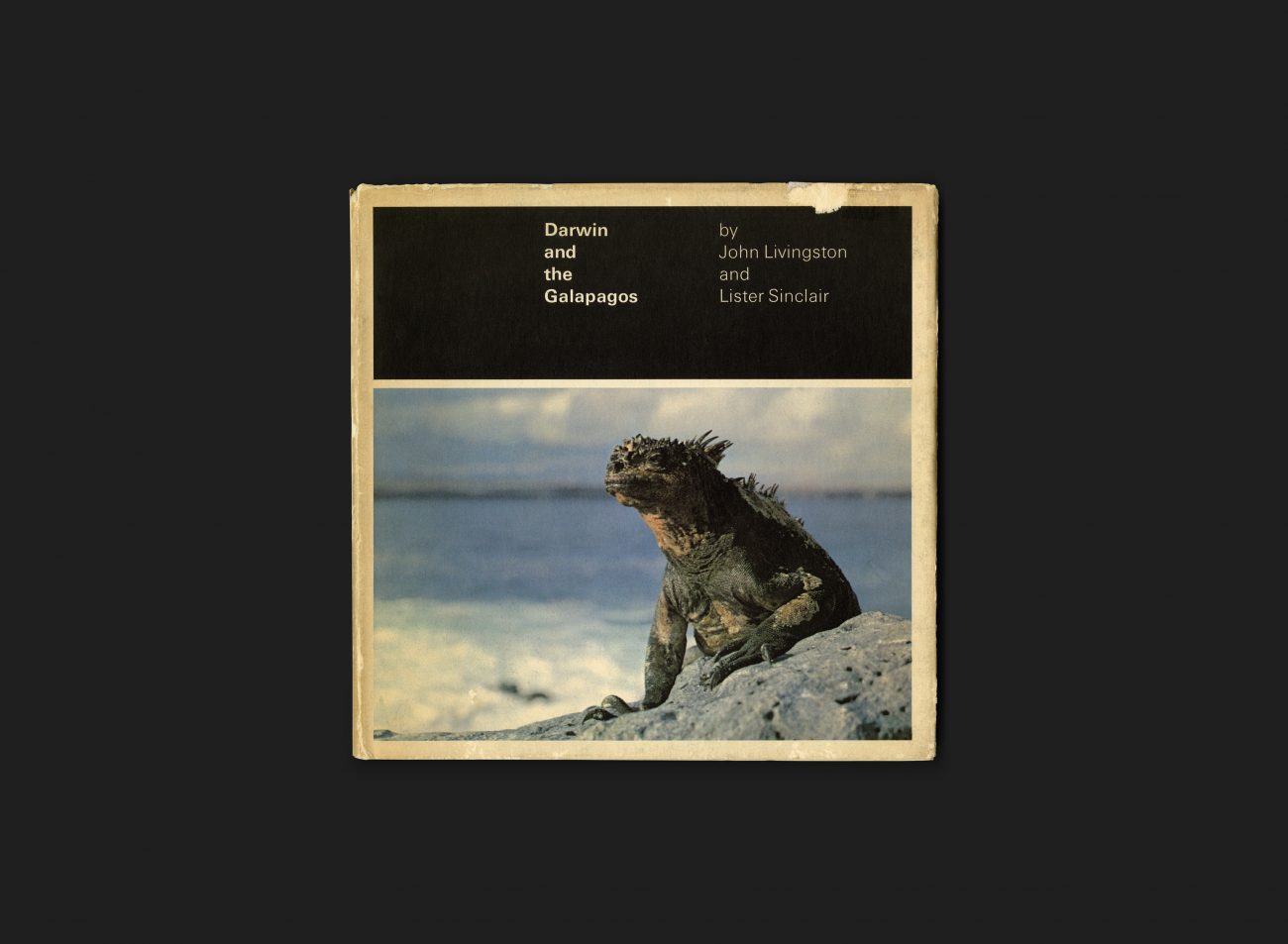
Alison and I are visiting the Galapagos as part of an Adventures Abroad Experiential Ecuador tour led by Ecuadorian native Alfredo Meneses. In a general post covering all aspects of this tour I was appreciative of the fact that our visit to these islands would not be by cruise ship, but rather that we would be spending time on land at San Cristobal, Isabela and Santa Cruz islands, all of which are completely different. Our first stop is San Cristobal which we reached on an Avianca flight that originated in Quito, but stopped in Guayaquil on the way, which is the case with most flights to these islands. You cannot fly into the Galapagos from anywhere but the Ecuadorian mainland and you need to get something equivalent to a visa before boarding the flight. We had filled out these forms months earlier and received a document which we gave to Alfredo who took care of the rest of the procedure. So if you think you can just hop on a plane and go to the Galapagos forget it. This is one place where travelling on an organized tour is almost mandatory.
The airport on San Cristobal is tiny and we were off the plane and onto a waiting bus in a matter of minutes. We were greeted by our local guide Jairo who would be with us during our stay on San Cristobal. Alfredo, who used to live on the Galapagos, explained that the islanders have a lot of say in how the islands are managed and compared it almost to a semi-autonomous state with jobs for the local people a top priority. At the airport there are three entry points – one for foreign nationals, one for mainland Ecuadorians and one just for Galapagos residents. I was frankly glad to know that the islanders were not being exploited and calling the shots on their native soil.
History of the Galapagos
Before getting into the specifics of our visit to the Galapagos I’ll give a little detail on the history of the islands. Aside from the Antarctic, the Galapagos islands were one of the few places on earth that were not populated by what we generally would call Indigenous peoples. When a Spanish boat headed from Panama to Peru was blown off course in 1535 and ended up sighting then unknown islands bishop Tomás de Berlanga became the first person to ever set foot on them. On his return to the mainland he described all the strange animals he saw there, especially the giant tortoises and thus the Spanish name for these creatures, galapagos started showing up on 16th century maps and stuck. However, nobody seems to have thought a great deal about the islands for centuries. The most frequent visitors seem to have been English pirates who gave the various islands English names that were still in use when its most famous visitor Charles Darwin arrived at San Cristobal in 1835. He only spent a month in the Galapagos all told, visiting four different islands, making notes and collecting specimens, but it may have been the most momentous visit in history as it changed the entire view of life on earth as we know it.
Shortly after gaining independence, Ecuador claimed the Galapagos and renamed the islands with the Spanish names in use today. Nobody seems to have objected. What was then just a bunch of volcanic islands with some pretty strange creatures living there turned out to be one of the wisest territorial acquisitions ever. However, it took Ecuador a while to realize what they had. No serious attempt to colonize the islands was made and it was used mainly to house convicts. By the 1920’s Ecuador was so broke that it looked to sell the islands and there were a number of interested buyers including the United States, Chile, Japan and Germany. Fortunately for Ecuador, geopolitical wrangling made sure that every attempt to purchase or set up a military base was thwarted by the rivalry between potential buyers.
The first real attempt at settlement came in the 1920’s and 1930’s from Europeans who were seeking a simple life. Ecuador offered them land grants and some descendants of these Europeans still live on a number of islands, but it never amounted to any great numbers. The United States built a military base on the small island of Baltra during WWII and it is still the main airport on the islands and the point from where we will depart to the mainland. In 1959 Ecuador finally realized what an ecological treasure these islands were and designated them a national park. The first tourists arrived in 1960 and there has been a steady increase ever since with tourism being by far the largest financial driver of the islands economy. In 1978 UNESCO inscribed the Galapagos as a World Heritage Site with this description:
The Galapagos Islands area situated in the Pacific Ocean some 1,000 km from the Ecuadorian coast. This archipelago and its immense marine reserve is known as the unique ‘living museum and showcase of evolution’. Its geographical location at the confluence of three ocean currents makes it one of the richest marine ecosystems in the world. Ongoing seismic and volcanic activity reflects the processes that formed the islands. These processes, together with the extreme isolation of the islands, led to the development of unusual plant and animal life – such as marine iguanas, flightless cormorants, giant tortoises, huge cacti, endemic trees and the many different subspecies of mockingbirds and finches – all of which inspired Charles Darwin’s theory of evolution by natural selection following his visit in 1835.
Today there are still less than 35,000 permanent residents, most of whom live in the small city of Santa Cruz. In my introductory post on Ecuador I explained that suggestions that the Galapagos was ‘over touristed’ were simply nonsense. In 2021 it had only 136,000 visitors of whom 60% were Ecuadorians. No doubt the numbers will rise as the pandemic subsides, but what I witnessed during the week we spent in the Galapagos was one of the most sustainable tourism regimes I have encountered anywhere.
OK, enough background, let’s rejoin Alfredo and Jaire and start exploring San Cristobal.
San Cristobal
San Cristobal is the easternmost and oldest of the volcanic islands that make up the Galapagos. It was the first to be settled and contains the only freshwater lake on the entire archipelago. About 5,400 of its 6,000 residents live in Puerto Baquerizo Moreno which is also the capital city of the Galapagos province. It has the largest fishing fleet on the islands as well as a naval base and government offices, but to be honest it felt like tourism was by far the major activity. Also, I never heard anyone refer to the place as anything other than San Cristobal.
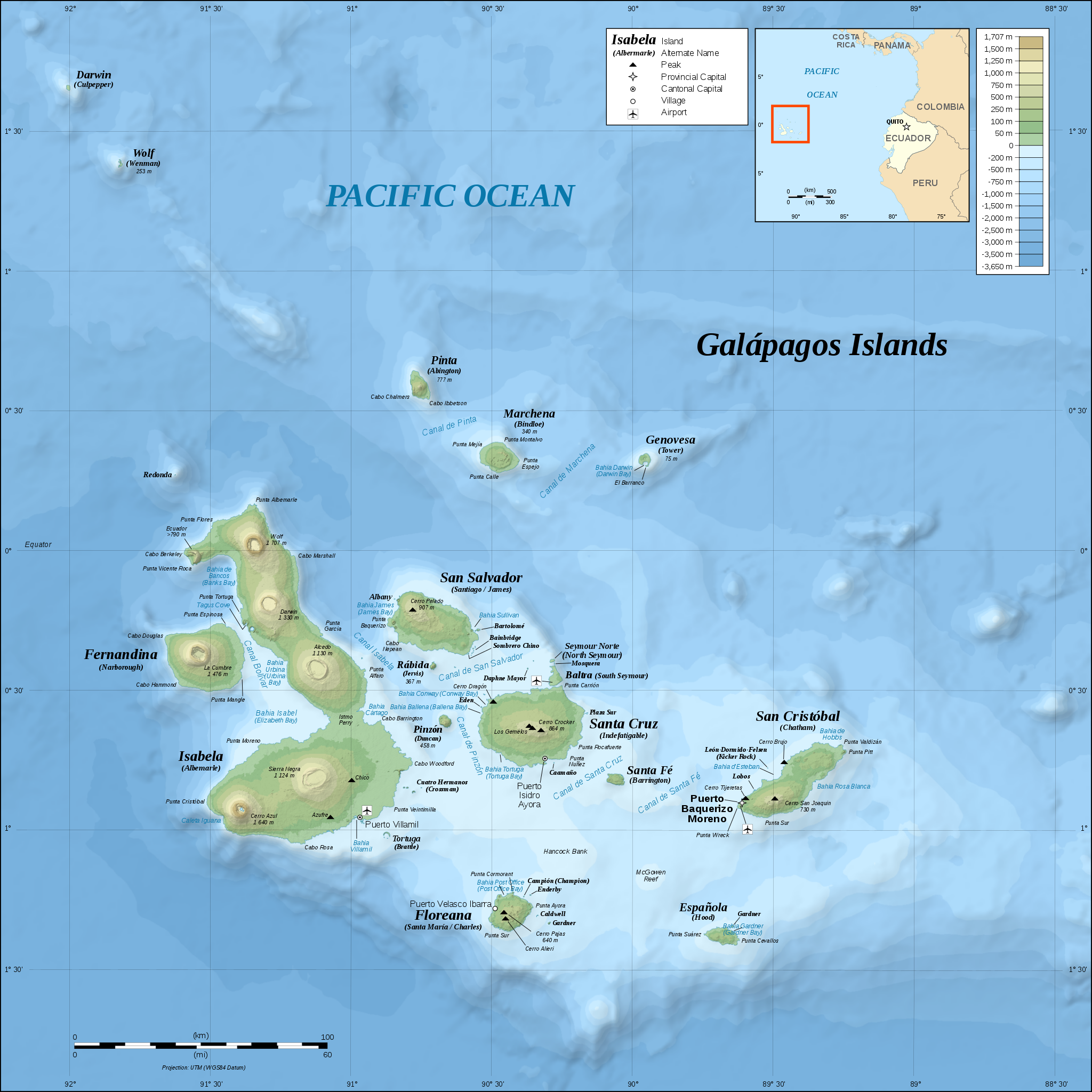
As noted, it was a very short bus ride from the airport to our hotel, which was right on the town’s waterfront. We dropped our bags in the lobby, but before checking in Jairo told us to follow him. Literally across the street from the hotel there is a boardwalk that crosses over a small cove. This is looking at it from the hotel.
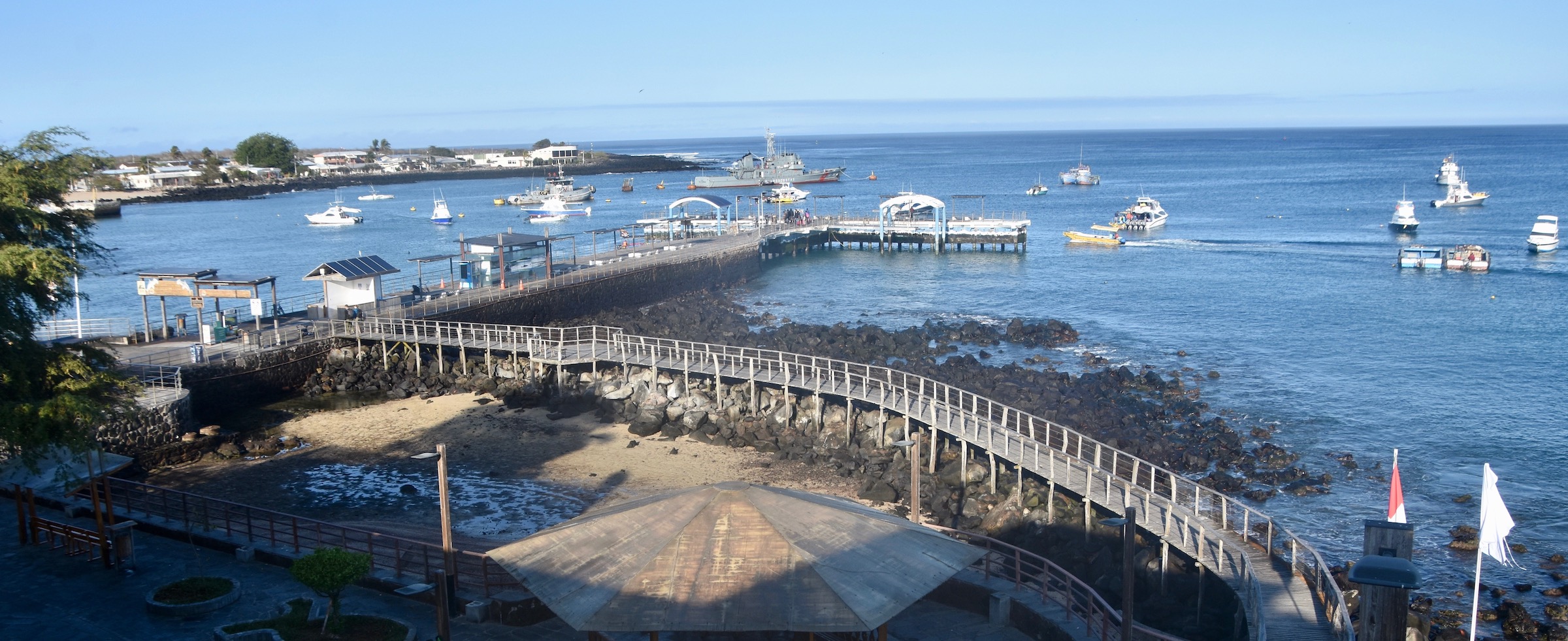
Here we got our first look at the wild life of the islands including the Galapagos sea lion which is an endemic species smaller than the California sea lion from which it evolved, the unique marine iguanas and if you look closely, the brightly coloured Sally Lightfoot crab. Generally you don’t expect seeing the native fauna to be this easy, but on San Cristobal it really is.
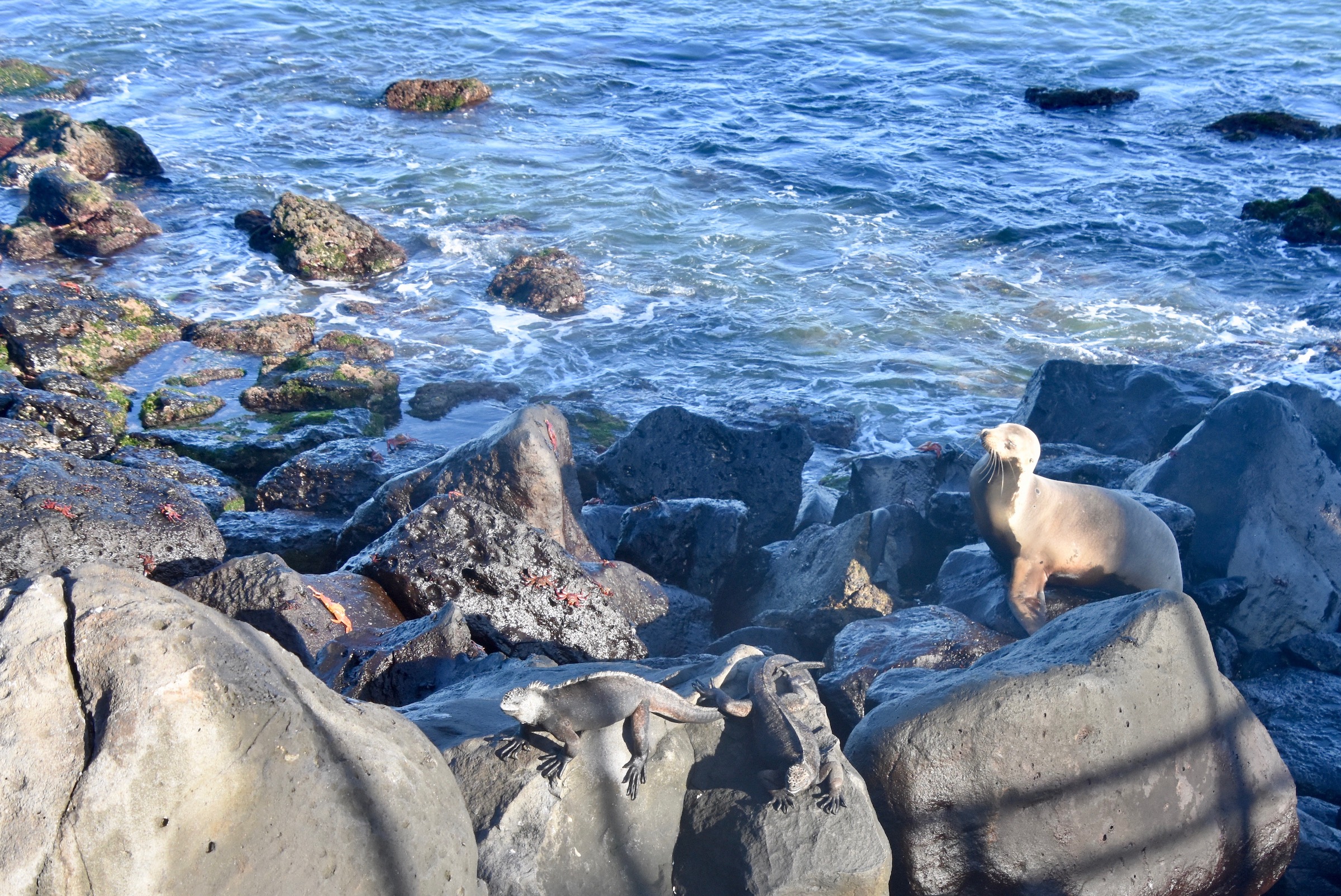
Here’s a closer look at one of the Sally Lightfoots.
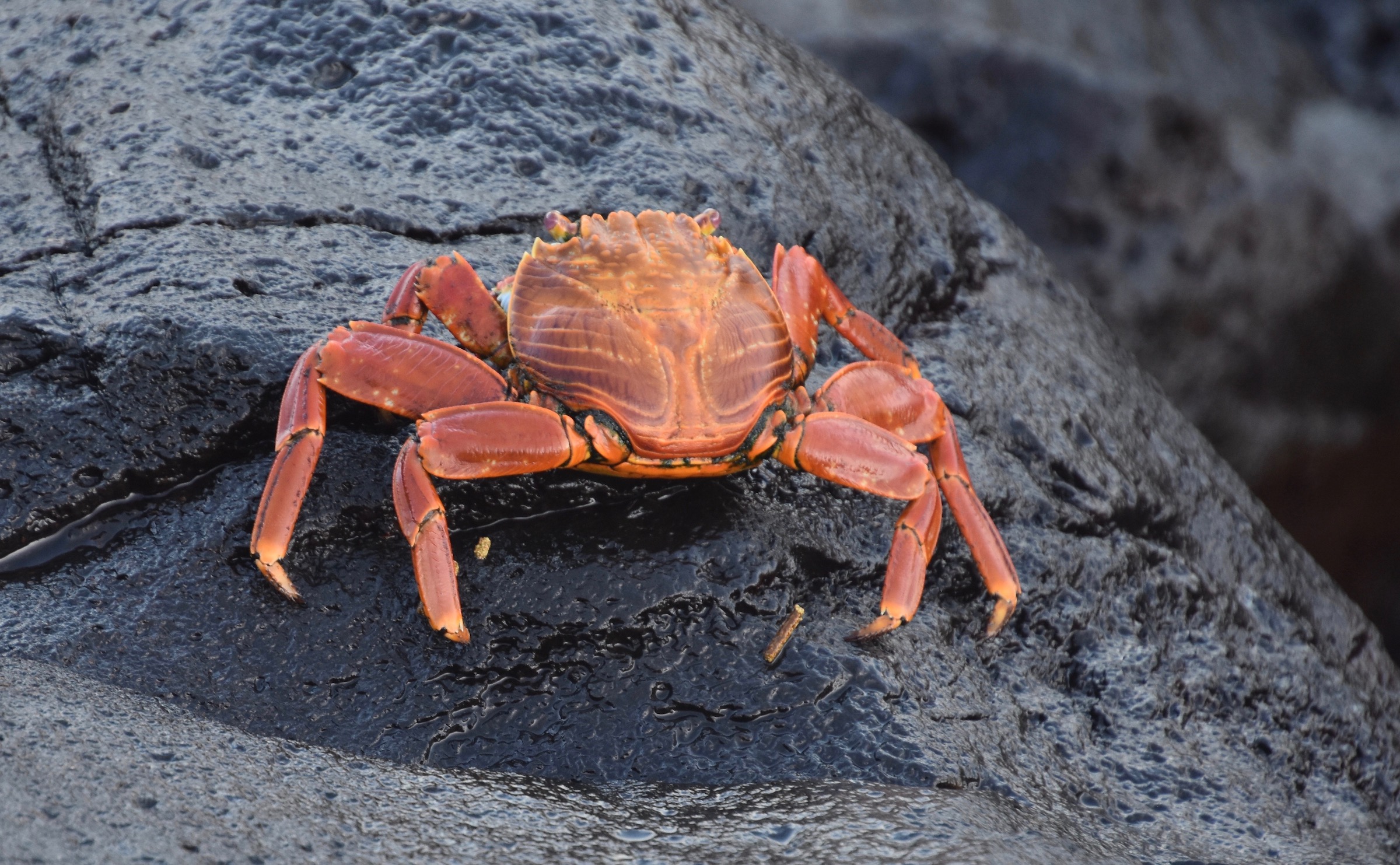
And Alison’s first close up with a marine iguana. The fact that many species evolved on these islands without any human presence and in many cases without predators, makes them generally unfazed by people and they carry on with their business seemingly oblivious to anyone watching them. So you needn’t worry about not seeing a lot of the species you probably have on your life list when visiting the Galapagos. During our time here the only species I wanted to see but didn’t were the flightless cormorant and the waved albatross, but that was small beer compared to those I did see.
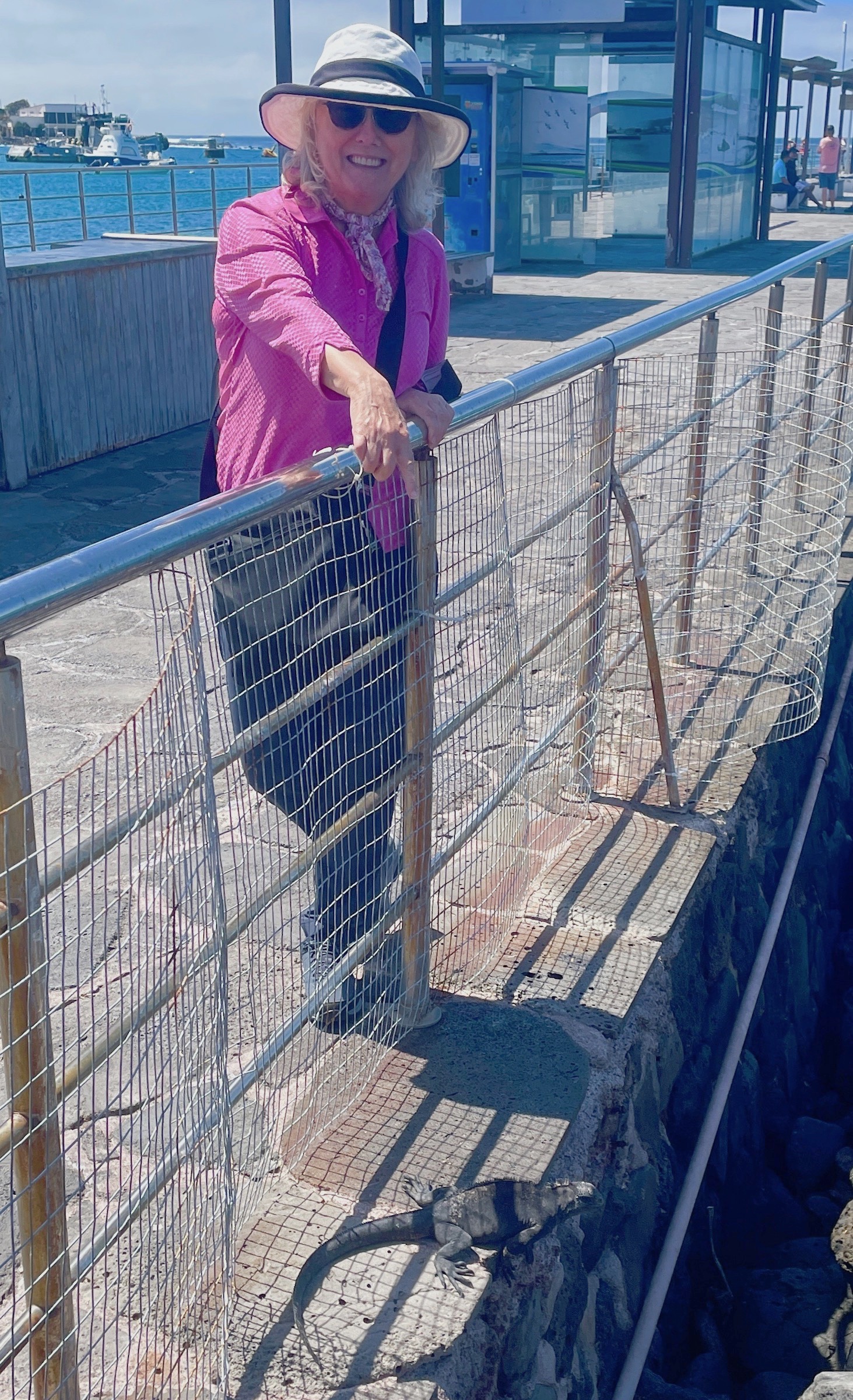
After this brief introduction to the creatures on the San Cristobal waterfront we checked into the Galapagos Sunset Hotel where most of us got rooms with a great view of the harbour.
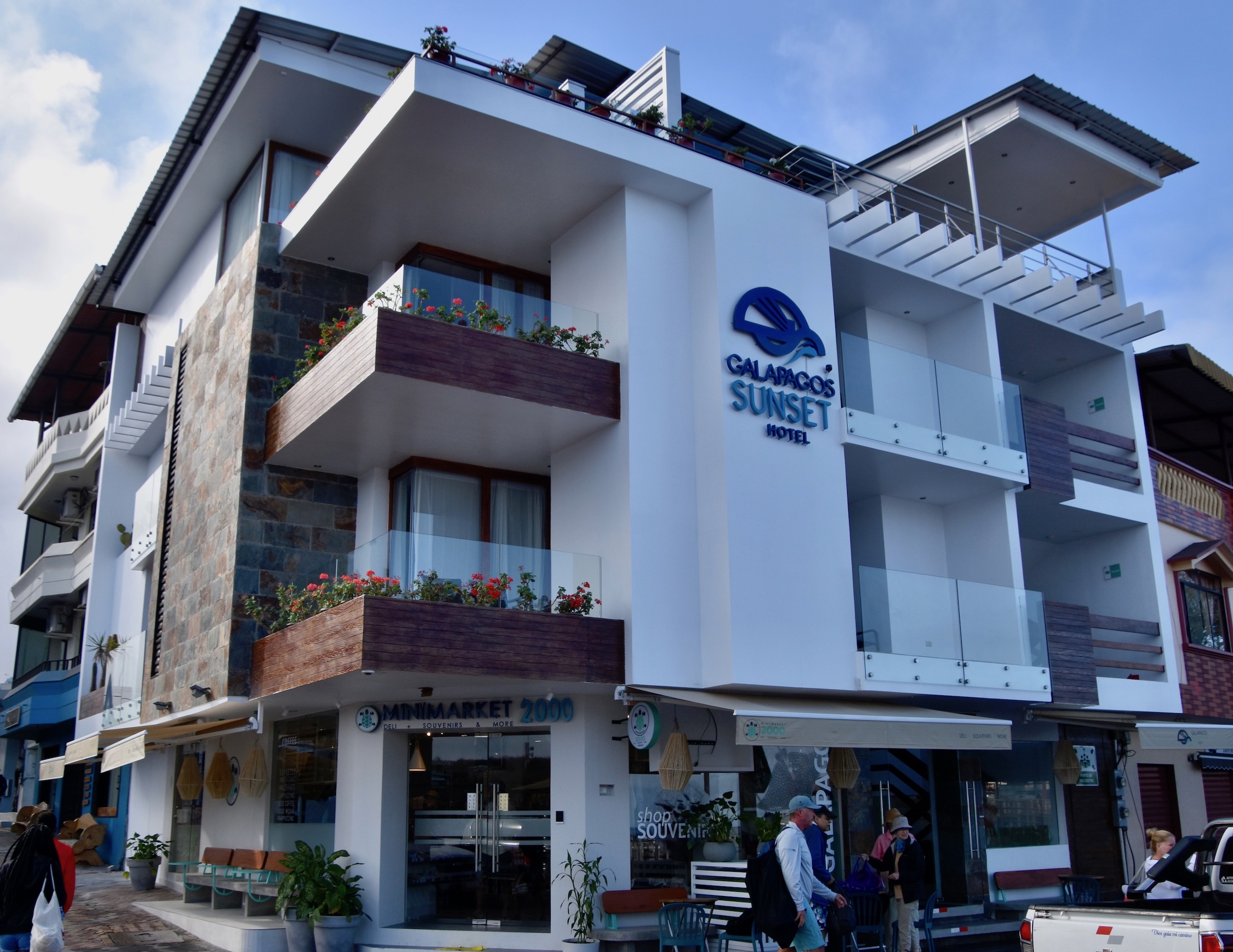
This is the San Cristobal harbour with a few small freighters and inter island cruise ships as well as fishing and dive boats. You can also see the Ukrainian flag being flown between the Ecuadorian and Canadian, indicating where this place stands on that horrible incursion by Russia.
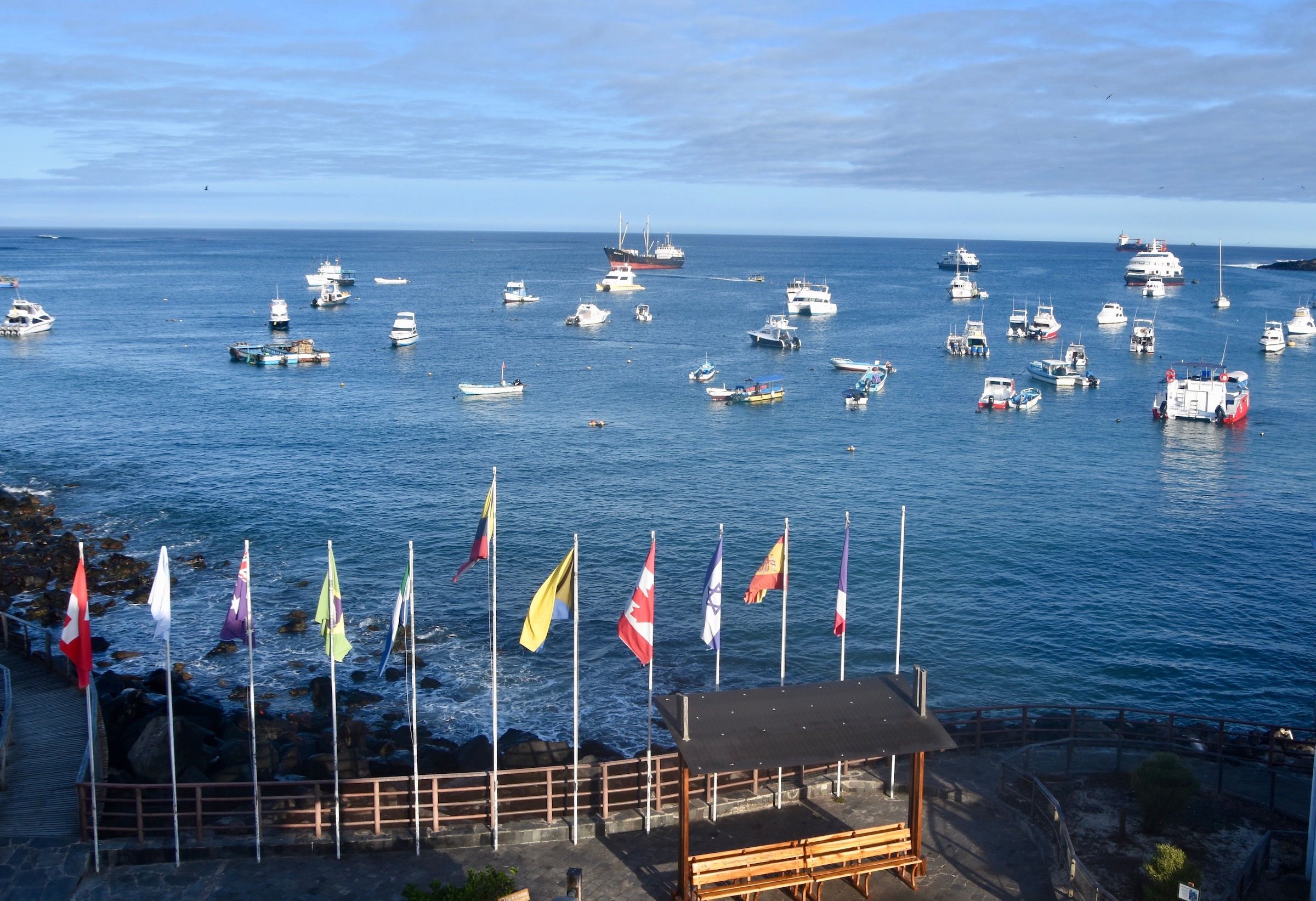
This is another view. I’m honestly not sure what I expected on coming to the Galapagos, but I know it wasn’t this and I mean that in a good way. If I had been teleported here without knowing where I had landed my best guess would have been one of the dryer Caribbean islands.
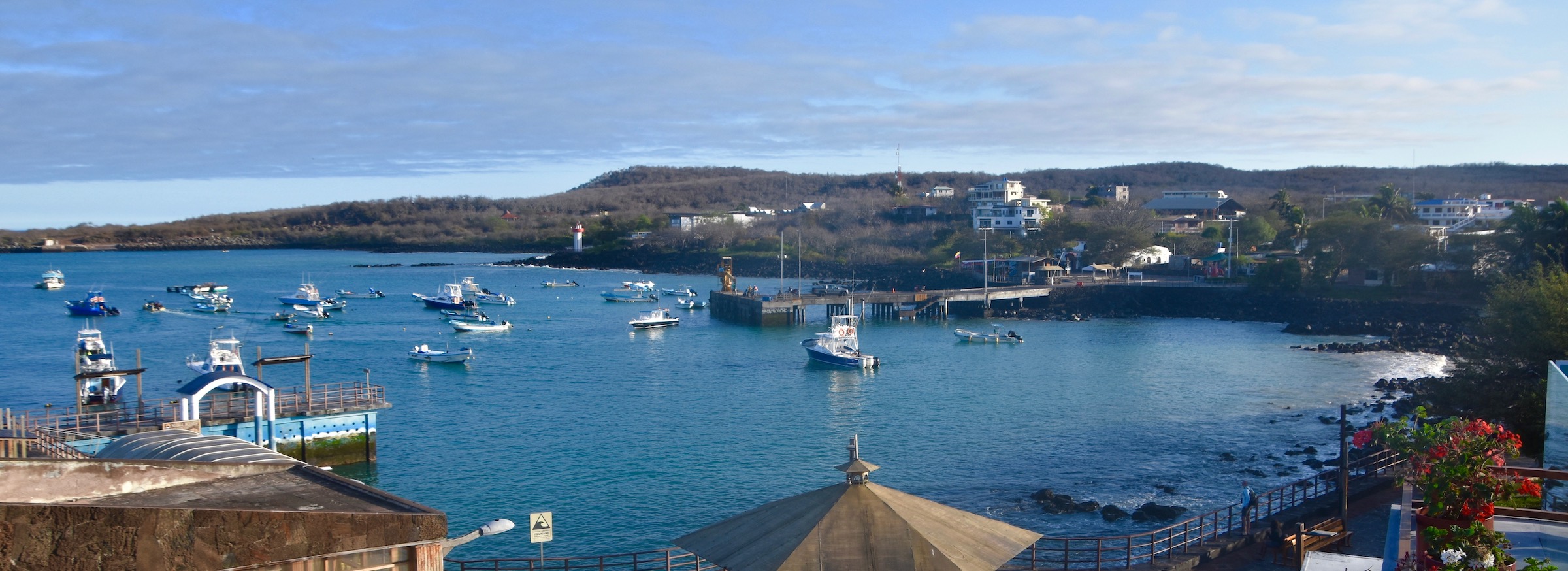
After freshening up Jairo took us on a walk to visit the Galapagos National Park Interpretation Centre which is just outside of the town. There were lots of interesting things to see along the way including meeting up with Charles Darwin. This is the very spot where he first came ashore and took note of the giant tortoises and the small birds we now call Darwin finches. Only after visiting other islands in the Galapagos did he notice that the tortoises and finches differed significantly from island to island and seemed to have adapted differently to different environments. It took him many years to figure out what was going on and it wasn’t until 1859 that he published On the Origin of the Species which expounded the theory of natural selection which is the driving force behind evolution. There was something momentous for me in meeting the man on this place that I had dreamed about for so long.
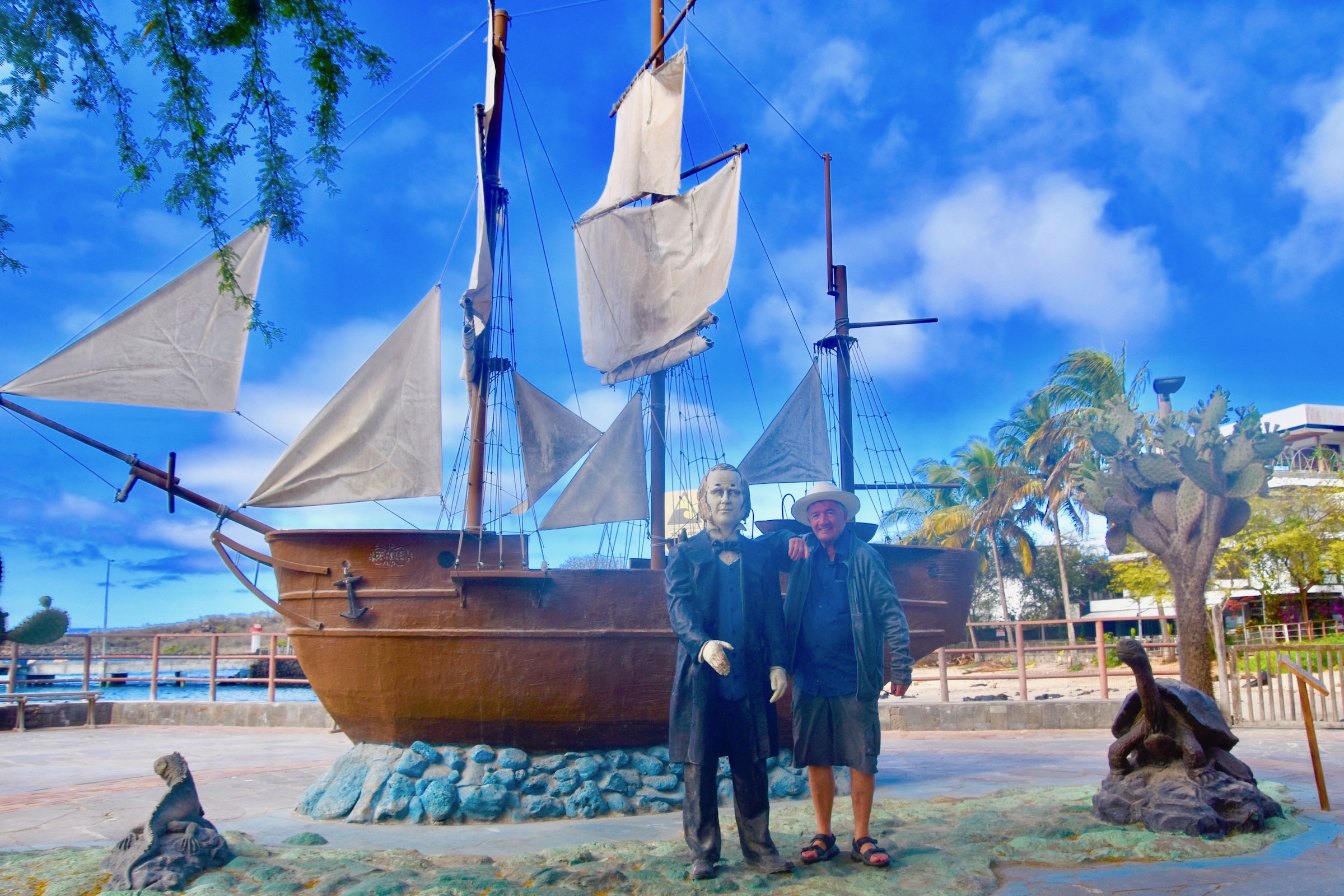
The sea lions on San Cristobal are not like the ones you see on the San Francisco waterfront or other places up and down the Pacific coast. They generally stick to basking on piers and breakwaters. The ones on San Cristobal and everywhere else we went on the Galapagos like to fraternize. They literally walk or waddle in the same places the people do. They occupy park benches which they often fight over.
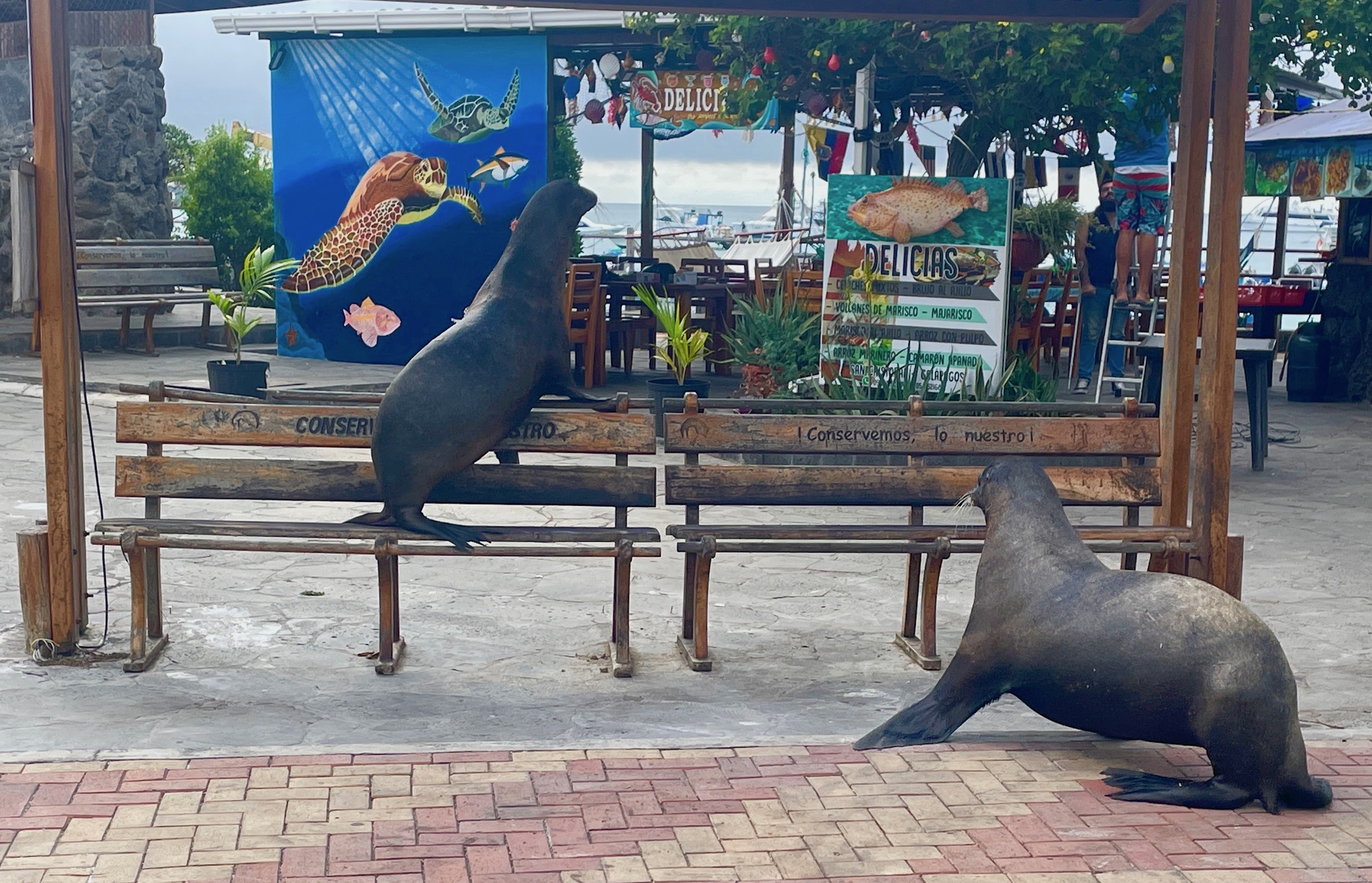
They lie on the beach alongside human sunbathers. And when they need to cool off they go swimming alongside them as well.
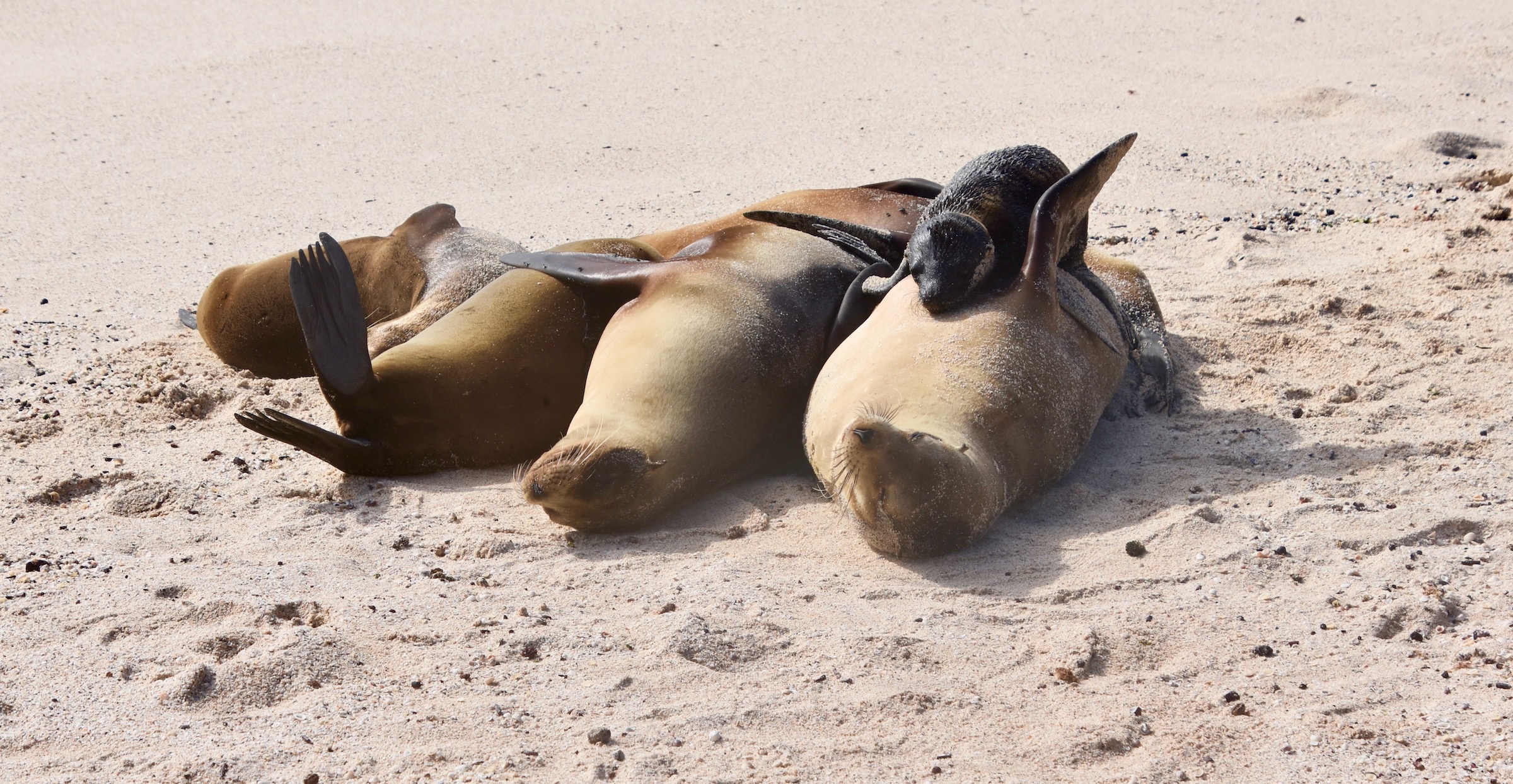
They also can be pretty nosy. This one was poking around in this woman’s back pack looking for a snack. The bottom line is that the sea lions are a constant source of amusement on San Cristobal.
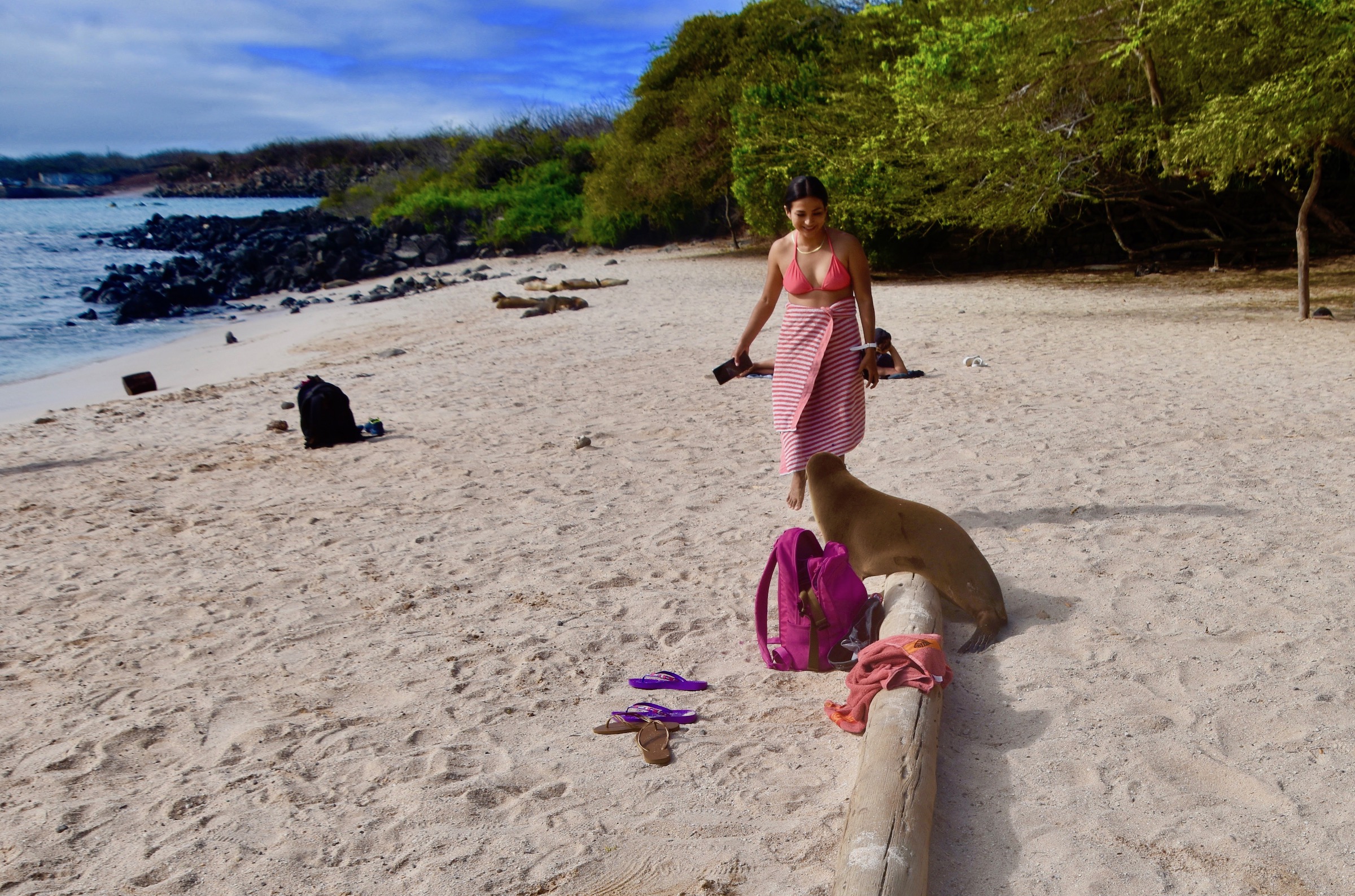
I can’t say that the Interpretive Centre was one of the highlights of the Galapagos visit, but it was very informative. Here Jairo is explaining the geology of the islands.
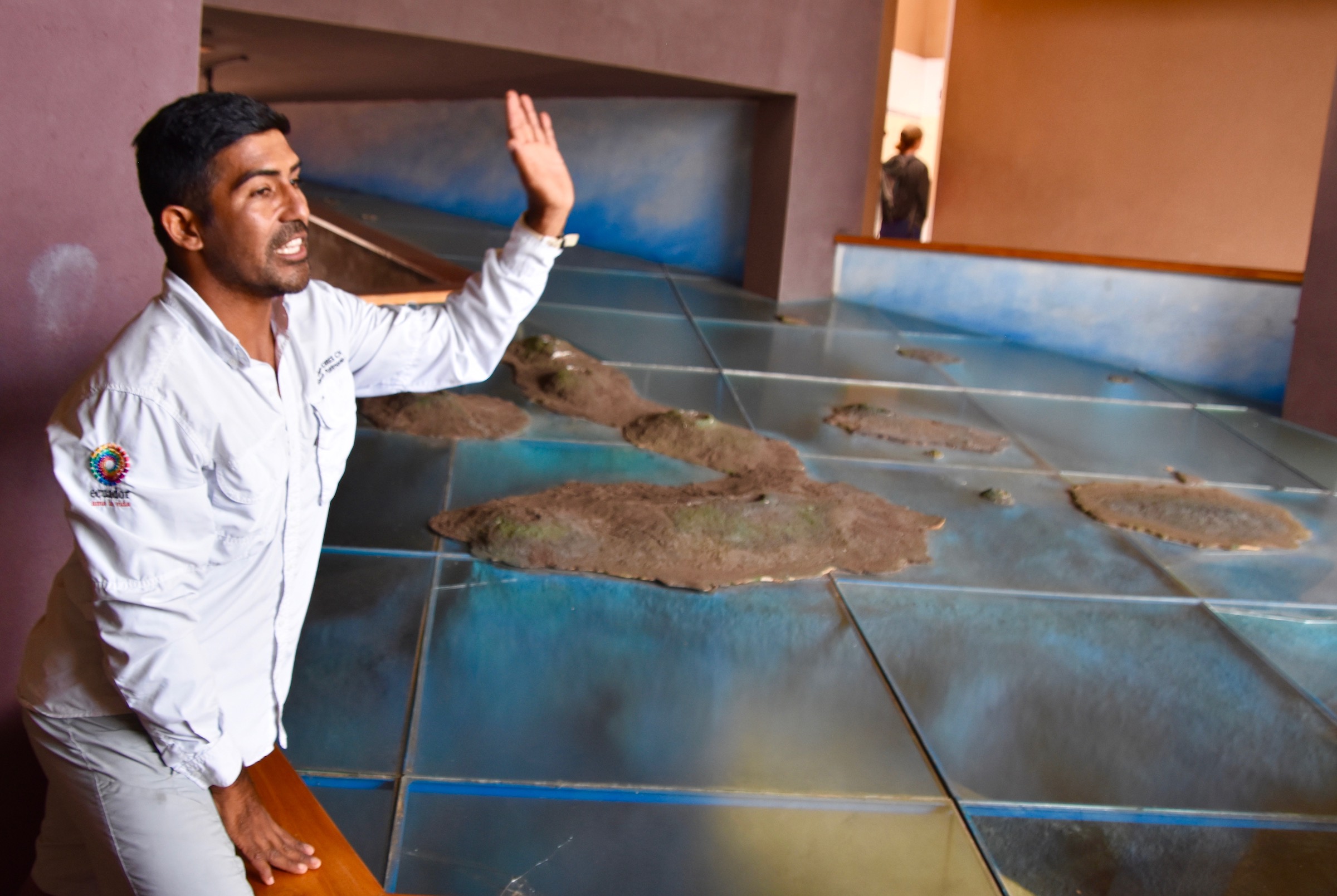
What was more interesting was the walk through the dry scrubland to nearby Punta Carola beach. Once again Galapagos had surprised me in a pleasant way. Pristine beaches were not what comes to mind when thinking about these islands, yet there are great ones to be found on most of them. In the next post we’ll visit a truly spectacular remote beach on San Cristobal.
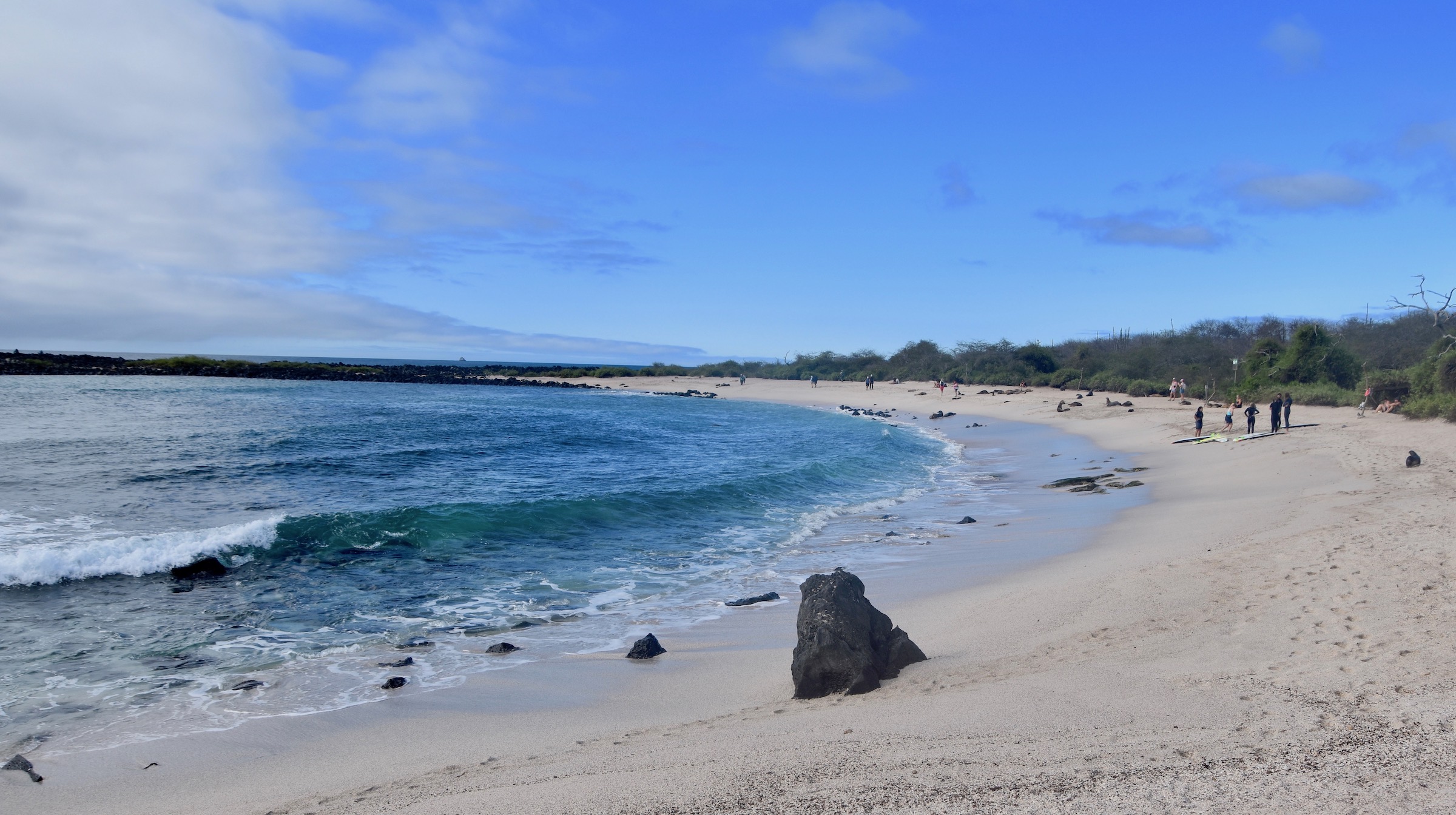
Prior to setting out for the Interpretive Centre Alfredo took us to a dive shop where we were all fitted for wet suits and snorkelling gear. Despite the fact the Galapagos is virtually on the equator, the famously cold Humboldt Current makes its way up to them from the Antarctic making the waters too chilly to snorkel in without a wet suit. We had the option of snorkelling here, but Alison and I took a pass. In my experience it is much more difficult to walk out through waves like this which were actually much larger than this photo makes them appear, than to go in from a boat. Those that did go in did not report having a great time, but one couple was very enthused about being in the water with the sea lions. So if that is something you want to do, this is the place to do it. Otherwise, don’t feel guilty about giving it a pass because there are much better opportunities coming up.
On the way to and back from Punta Carola beach we encountered a variety of Darwin finches as well as the only warbler found on the islands. The yellow warbler is found all throughout North America and as far south as Peru. How this species got here and no others managed the feat is anyone’s guess, but they are ubiquitous on San Cristobal and elsewhere.
I started this post with a photo of a marine iguana on a book I treasured for over fifty years and I’ll end it by featuring the real thing. Trust me, you won’t have any trouble getting good photos of them, like this large male.
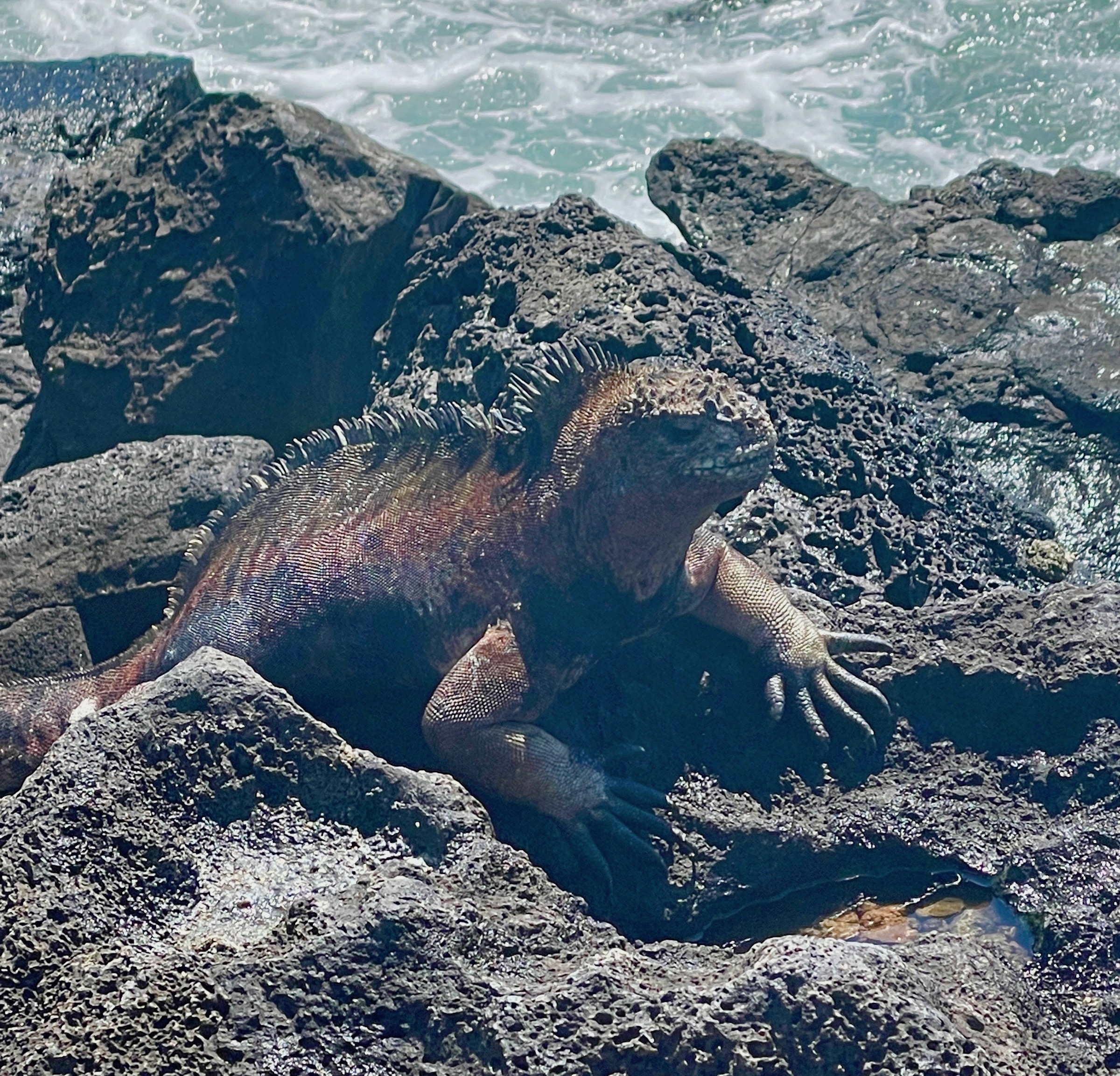
In the next post we’ll take our first of a number of boat trips on the Galapagos and visit the famous Kicker Rock. I hope to see you aboard.

